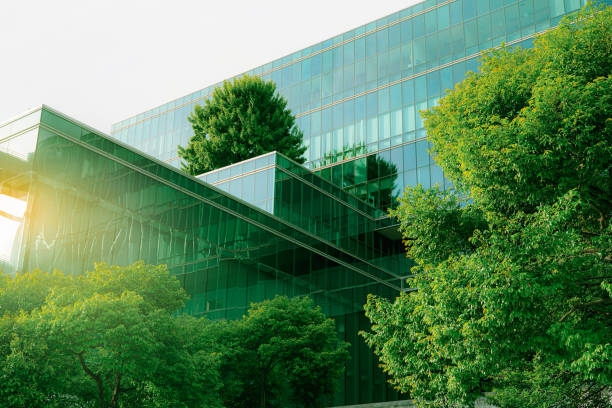Leveraging Biophilic Design in Industrial Spaces
Integrating nature into industrial environments for enhanced productivity and well-being In today's rapidly evolving industrial landscape, companies are seeking innovative ways to boost productivity, employee satisfaction, and overall operational efficiency. One groundbreaking approach gaining traction is the incorporation of biophilic design principles into industrial spaces. This strategy goes beyond traditional workplace improvements, tapping into humans' innate connection with nature to create environments that foster creativity, reduce stress, and ultimately drive business success.

The application of biophilic design in industrial settings is not merely about adding potted plants or nature posters. It involves a comprehensive approach that incorporates natural light, vegetation, natural materials, and even simulated natural experiences. These elements work together to create a more harmonious and productive work environment.
The Business Case for Nature-Inspired Spaces
Implementing biophilic design in industrial spaces isn’t just an aesthetic choice; it’s a strategic business decision with tangible benefits. Studies have shown that exposure to natural elements in the workplace can lead to significant improvements in employee well-being, productivity, and creativity. For instance, research published in the Journal of Experimental Psychology found that the presence of plants in office spaces can increase productivity by up to 15%.
Moreover, biophilic design can contribute to reduced absenteeism and lower healthcare costs. A study by the University of Oregon found that employees with views of nature took 26% fewer sick days compared to those without. This translates to substantial savings for companies, especially in industries where downtime can be costly.
Practical Applications in Industrial Settings
Implementing biophilic design in industrial spaces requires careful planning and adaptation to the specific needs of the environment. Here are some practical ways companies are incorporating these principles:
-
Natural Light Integration: Maximizing natural light through strategic window placement, skylights, or light tubes can dramatically improve the work environment. In areas where direct sunlight is not feasible, full-spectrum lighting that mimics natural light can be used.
-
Living Walls and Indoor Gardens: Vertical gardens or living walls can be installed in break areas, corridors, or even production floors where appropriate. These not only improve air quality but also provide a visual connection to nature.
-
Biomorphic Forms and Patterns: Incorporating natural patterns and shapes into architectural elements, such as curved walkways or honeycomb-inspired storage solutions, can subconsciously evoke a sense of nature.
-
Natural Materials: Using wood, stone, and other natural materials in construction and furnishings can create a more organic feel within industrial spaces.
-
Water Features: The sound and sight of water can have a calming effect. Small water features or even digital displays of flowing water can be incorporated into rest areas or high-stress zones.
Overcoming Challenges in Implementation
While the benefits of biophilic design are clear, implementing these principles in industrial settings comes with unique challenges. Safety regulations, machinery requirements, and the need for sterile environments in some industries can limit the extent of natural elements that can be introduced.
To address these challenges, companies are getting creative. For instance, in clean room environments where live plants are not permitted, high-quality artificial plants or nature-inspired art can be used. In areas with heavy machinery, safety barriers can be designed to incorporate natural patterns or colors.
Another consideration is the initial cost of implementation. While biophilic design can lead to long-term savings through increased productivity and reduced absenteeism, the upfront investment can be significant. Companies are addressing this by phasing in changes over time or starting with pilot areas to demonstrate ROI before full-scale implementation.
The Future of Biophilic Industrial Design
As awareness of the benefits of biophilic design grows, we can expect to see more innovative applications in industrial settings. Emerging technologies like virtual and augmented reality may play a role, allowing companies to create immersive natural experiences even in the most sterile environments.
Additionally, the integration of biophilic design with sustainable practices is likely to become more prevalent. For example, living walls can be designed to filter air and reduce energy costs, while natural lighting solutions can decrease reliance on artificial lighting, lowering energy consumption.
Key Strategies for Implementing Biophilic Design in Industrial Spaces
• Conduct a thorough assessment of your current space to identify areas for biophilic integration
• Start with low-cost, high-impact changes like adding plants or nature-inspired artwork
• Prioritize natural light and views of outdoor green spaces where possible
• Incorporate natural materials and textures in furnishings and architectural elements
• Consider the sensory experience: include elements that appeal to touch, smell, and sound
• Educate employees about the benefits of biophilic design to encourage engagement and care of the new elements
• Monitor and measure the impact on productivity, absenteeism, and employee satisfaction to justify further investments
In conclusion, biophilic design represents a powerful tool for industrial companies looking to enhance their work environments and boost overall performance. By thoughtfully integrating elements of nature into industrial spaces, businesses can create more humane, productive, and inspiring workplaces. As this approach continues to evolve, it has the potential to revolutionize the way we think about industrial design, paving the way for a more harmonious relationship between nature, technology, and human productivity.





